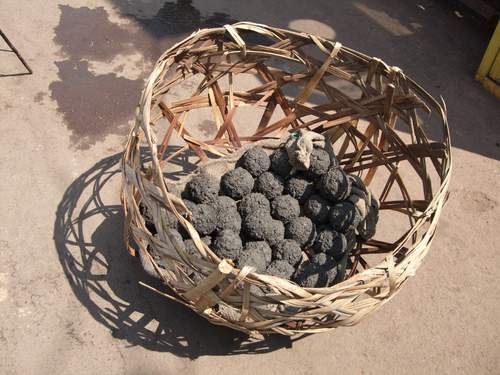
A basket of coaldung put out to dry. Homes have begun to use coaldung balls as a cooking fuel
While in the hills of western India last week (they're called the 'Western Ghats', and run from northern Maharashtra state all the way down the edge of the Deccan plateau to merge with the Nilgiri hills of south Karnataka) I saw something I haven't seen since my schooldays. The something is old-fashioned fuel balls. You can hold one of these lightweight balls in your hand, for they are around 8-9 cm in diameter, their colour a slatey grey flecked with brown. You only rarely see them being sold in the small provision shops in these villages, for the fuel balls are made at home. They require two ingredients: cow dung and coal dust.
Hill village households in this region of western India use a variety of fuels and power sources to get their work done and keep their homes running. Electricity that runs through high-tension cables and then the local 220 volt, 50 hertz distribution network is available, but not 24 hours a day, as the state government and central government would like to have us believe. The infrastructure to distribute kilowatts is certainly there (if rickety in most villages like these) but the watts themselves are being diverted elsewhere, to more demanding, more influential, more lucrative customers in cities and towns. For the state electricity generation and distribution utilities, these villages are barely fourth tier customers, for they are marginal and have little or no voice. If these households get five or six hours a day of electricity (evenings is when they need it most) they're considered to be on the grid.
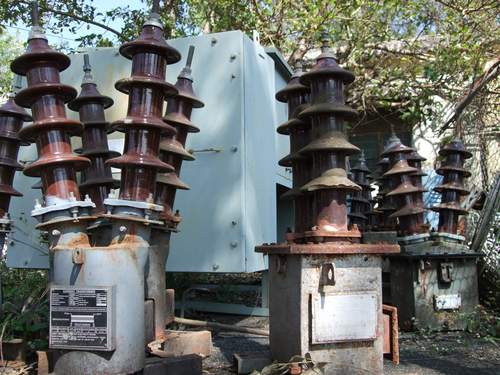
Outdated and damaged power equipment in a district headquarters, western Maharashtra, India
That may be enough to allow the children to do their homework and to provide light just enough to cook with, but what of the rest of the energy needs of the household? That's where the coaldung fuelballs comes in. Fuel to cook with (and to warm the home during winter nights) comes in several forms. Electricity is never one of them (as it is in the west) for it is simply too expensive and too wasteful. Liquefied petroleum gas (LPG) is the cooking fuel most preferred, but at Rs 330 per cylinder (EUR 5.3) it is already expensive and will become more so if petroleum products prices are revised upwards, as the central government plans to do soon, now that the country's annual budget for 2010-11 has been passed. If the cost of a domestic LPG cylinder (14.2 kilos of the stuff) is raised by around Rs 50 as planned, tens of thousands of hill and other households in Maharashtra and other Indian states will reduce their consumption of LPG. The rural release of LPG demand will instantly be absorbed by the appetite of urban households, so for India's 'oil marketing companies' (as the public sector giants are known, the ones that buy crude oil, refine it and turn it into LPG and other products) it will become a question of reallocating supply.
That's why the strengthening of the woodfuel economy (see 'With Twig and Dung', Energy Bulletin) and now the revival of the coaldung balls. These are found in households that are current consumers of coal. This is a fuel that is bought by the sackful and the current cost of one HDPE sackful of about 25 kg of coal is around Rs 300 (EUR 4.8; it's cheaper on the Deccan plateau, but that's also because this western edge of the plateau is well serviced by road thanks to the highway that runs from the fast-growing city of Pune all the way south to Bangalore, or Bengaluru, better known to the west as India's Silicon Valley for its info-tech industry). The coal needs to be broken up from large nuggets to pieces no larger than the size of a tennis ball so that they can be heaped on the combustion trays of the village stoves. Whoever it is in the family who breaks up the coal, they are careful to do it directly in the sack. The result is that by the time half the coal pieces in a sack have been used, there's a deep layer of coal fines lying at the bottom of the sack.
The fines collected from a single sackful are stored carefully. That's when the second part of the coaldung fuel mix is readied. If a household owns a cow or a buffalo, they will be collecting the cattle dung anyway. If they don't, their first choice is to look for a neighbour or extended family member who will gift them dung. If not, they will have to buy dung from a family that maintains cattle on their land. They would look for around a basketful of dried dung (that's easier to move around), a typical shallow hill basket being around 75 cm across and about 25 cm deep. Having secured their cattle dung, they will then use an old drum, pour in some water, and add the dung cakes, mixing it so that the solution turns to a thick slurry. It needs an experienced hand to do this, for the coal fines must be added when the consistency is just right. The coaldung balls are shaped by hand - just as the dungcakes are - and when dry they are stored in deep and wide baskets lined with old newspaper.
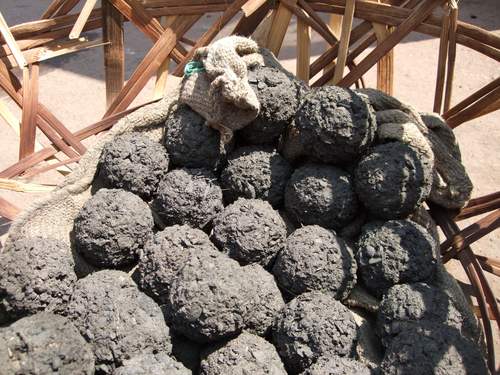
A closer view of coaldung. For kerosene to take its place, a litre would have to cost less than EUR 0.50
They are there because households in these parts are in search of a more affordable fuel mix for cooking. I asked Chingubai, a matronly lady, mother of two and grandmother of three, whether she made these fuel balls at home too. No, was her reply, but I know that this year there are people who are making many 'golas' and selling them directly to other homes or through small village shops. Did she also use kerosene, I continued. Chingubai, who is around 60, grimaced. "I would use kerosene if there was any I could buy. You can't get but any at the ration shop (this is the fair price shop, part of India's enormous public distribution shops (PDS) network) even with a ration card, but I don't have a card, and I can't find any even anywhere else." She said a litre of kerosene costs around Rs 30 whereas at the PDS it would cost Rs 15. But there's none to be had, so Chingubai's kerosene stove lies there unused. Like most other households in these hills, she has a stove that burns kerosene, one for coal, and a third for LPG. "It's already too expensive for us to use LPG alone and when the price goes up we'll have to make the cylinder last longer." That's apart from an old-fashioned hearth for the reliable staple: woodfuel.
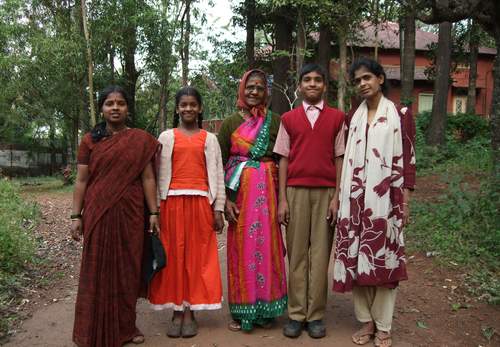
Chingubai and her family, in a village in Maharashtra state's Satara district. Note her grandson's neat and complete school uniform
It is the energy realities of household such as Chingubai's that escape the calculations of India's policymakers and the market models of state and private power generators. Multiply this energy-marginalised hill household by tens of thousands of others in rural India and the electricity poverty of a huge section of this country's population comes into focus. Yet 62 years after India gained independence, reliable electricity of quality enough to run at least basic appliances still eludes our rural households (not rural poor, for they are rich in traditional knowledge, in innovation skills and in the strength of their links with ecosystems). A valuable study carried out by Greenpeace India helps us understand this electricity poverty - or injustice, as the group calls it - and why it continues. Greenpeace India studied power supply in five states and three categories of habitation: metros or Tier 1 locations, towns or Tier 2 locations and villages or Tier 3 locations. The study found that in Tier 1 locations, electricity was available for at least 20 hours a day and more usually 24 hours a day. Tier 2 locations had electricity for 16-23 hours a day but ranged more towards the lower end of this band. It is the availability in Tier 3 locations, villages, that shows conclusively just how much they are discriminated against on this count, for the best-supplied village received no more than 19 hours of power a day, most villages received power for 11 or 12 hours a day and the worst-supplied village made do with electricity for just four hours a day.
What is to be done? What can be done with available technologies and rural needs? A solution lies with decentralised renewable energy systems - an answer not just for those villages with no electricity, but also for those connected to the grid (bureaucratic India proudly calls them 'electrified' even though, as Chingubai proves, they are wood-and-dung fired) and who must wait for the trickle left over after the cities have had their fill. Decentralised renewable energy systems for village India would connect hybrid systems of wind, micro-hydel, solar photovoltaic and biomass (depending on the location and availability of resources). Mini- and micro-grids would develop between village wards - we call them 'wadis' in western India - and clusters of hamlets. Pushed into a technology crossroads by the failure of massive centralised power systems, India now has the opportunity to build its future energy infrastructure in a way that provides for the needs of the rural population in a just and sustainable manner.
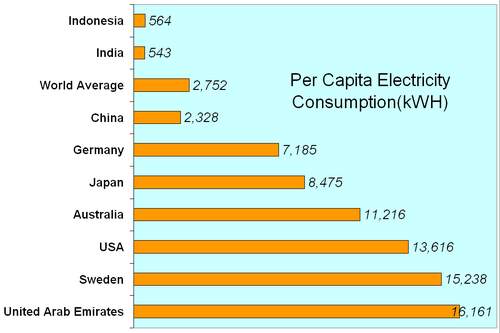
India's per capita electricity consumption compared. From 'Global electricity usage and CO2 emission (for 2007)', 'Key World Energy Statistics', International Energy Agency (IEA), 2009
Instead, in 2010-11 India is expected to import 35 million tonnes of coal to meet power generation targets, and this means coal-fired power generation. India's biggest power producer is the state-run NTPC Ltd (National Thermal Power Corporation), which has said it expects its coal consumption to rise rapidly as it expands capacity in response to a large and growing economy. India already imports coking coal from Indonesia, and NTPC is scouting for mines in that country and in Mozambique. The state-run firm accounts for a fifth of India's power generation capacity of 155,000 megawatts, burns 126 million tonnes of coal a year, and imports 10 million tonnes of that total. This urban-industrial driven trajectory is entirely opposite of what the hill households should be heading for: a basket of renewable generation technologies that are locally-managed and delivered. (How many vessels will burn furnace oil to move those 35 million tons of coal to India over thousands of sea kilometres?)
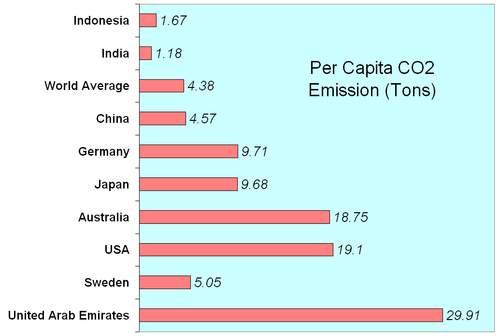
India's per capita CO2 emission tons compared. From 'Global electricity usage and CO2 emission (for 2007)', 'Key World Energy Statistics', International Energy Agency (IEA), 2009
India's rural energy injustice - which helps keep low the per capita CO2 emissions India uses as a bargaining chip about its climate change responsibilities - turns on its head the conventional view that improvements in energy efficiency encourage greater use of the services the energy helps to provide, which while helping push down energy intensity pushes up energy consumption. To illustrate, if lighting is available at a lower cost due to increased energy efficiency, more of it is likely to be used, leading to a net rise in per capita and community energy use. But our hill village households lie outside this model entirely for, being deprived of power by deliberately discriminatory policy, neither their poverty nor their solutions can be measured by urban-industrial means. For a genuinely inclusive state - as India loudly claims to be to her own citizens and to the world - such continuing energy poverty cannot be countenanced. The excuse proffered by the Government of India is that the numbers are huge, the backlog of unelectrified households huge, and the demands are numerous, all of which are acceptable as operating conditions. Yet the central government has elevated the consumption of at least a kilowatt per day of electricity as a basic right of every citizen. Is that right satisfied once a kilowatt has been metered, if not actually delivered? Any number of studies have shown that in rural India, electricity consumption has high value for households - Chingubai's example proves this - and where access exists, willingness to pay is high.
In 2002, a survey firm called Operations Research Group polled over 5,000 households in six Indian states to gauge the level of 'poor' households' willingness to pay. The baseline estimate arrived at was Rs 15-20 per kwh (EUR 0.24-0.32/kwh), which is in fact about four times the typical grid electricity charges at the time. This untapped willingness to pay is supported by evidence of thriving markets for private operators of small diesel generators who charge tariffs in a similar range. The lesson cannot be more clear and direct: rural households are able and willing to pay for reliable electricity services. Where good quality electricity connections exist, the positive impact on rural incomes can and does offset the cost of the electricity supply. For the members of such households to be forced to utilise their time and productive hours making coaldung 'golas' and drying them, searching for scarce kerosene, tramping up and down hillsides collecting fuelwood is a national disgrace.
Employers, consumers in spending stalemate that may delay recoveryHow to provide relief to rural Americans, create jobs, and lower emissions … all at once!
No comments:
Post a Comment